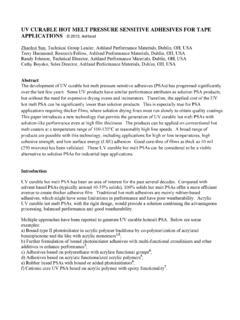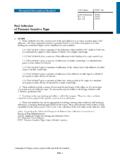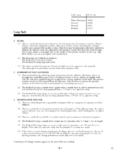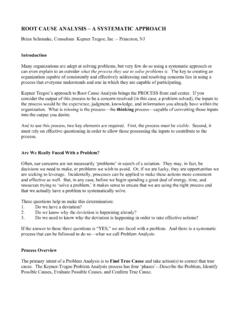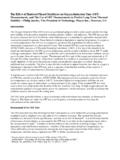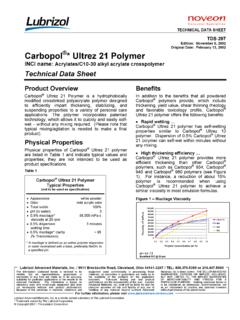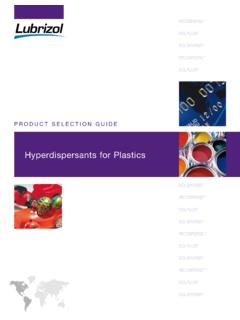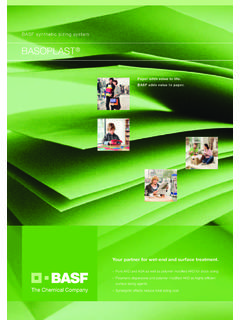Transcription of SURFACTANTS AND DEFOAMERS: ACHIEVING BALANCE IN …
1 SURFACTANTS AND defoamers : ACHIEVING BALANCE IN. polymer EMULSIONS. Don G. Pierson, President, Pierson Adhesive Consulting, Dresher, PA. Introduction Water-based polymers have long since replaced their solvent counterparts as the dominant technology in applied coatings. Applications include paints, adhesives, printing inks, textiles, and protective finishes for furniture and flooring. The successful formulator of water-based coatings understands the capabilities and downsides of SURFACTANTS and defoamers ; how they interact with each other, with the polymer , and with the continuous water phase, as well as their effects on in-process and end-use performance of the coating. In pressure sensitive adhesive emulsions, the primary objective in formulating with SURFACTANTS and defoamers is to achieve excellent machine coatability while minimizing any negative impact on performance properties.
2 Table 1. Coating and performance properties impacted by formulating emulsion PSAs Coating properties Performance properties to achieve to protect Dynamic wetting Tack, shear, peel Static wetting Blush resistance Flow and leveling Water/humidity resistance Foam Film integrity Mechanical stability Clarity, color Curtain stability Gloss, surface smoothness Surface Tension [The reader with a basic understanding of SURFACTANTS may wish to skip to the section on SURFACTANTS IN EMULSION FORMULATING]. An understanding of the mechanisms of SURFACTANTS and defoamers in water-based formulations begins with an understanding of the surface tension of water. Surface tension arises due to intermolecular forces in a liquid. A simple model of a water molecule shows its dipolar nature, which creates an attractive force between itself and each surrounding water molecule.
3 H+ H+. O- O- H+ H+ H+. O- H+ H+ H+. O- O- H+ H+ H+. O- H+ H+ H+. O- O- H+ H+. Figure 1: Water molecules showing dipolar attraction. Within the bulk of the water, each molecule is completely surrounded by others, giving each a net zero attractive force in all directions. However, each water molecule at the surface has air on one side, resulting in a net attractive force down into the bulk, creating surface tension, effectively a skin of water between the bulk water and the air. Liquid surface Net Force = 0 Net Force Figure 2: Water molecules in the bulk have equal attraction from all sides. Water molecules at the surface have a net downward attraction into the bulk. surfactant molecules all have dual functionality, combining lipophilicity (oil attraction).
4 On one end and hydrophilicity (water attraction) on the other, giving them the ability to concentrate at the interface between any liquid/liquid or liquid/air mixture. In the case of a water/air interface, the addition of surfactant causes the surface of the water to become less polar. As the lipophilic (hydrophobic) surfactant tails are attracted to the air, the water molecules at the surface are associated with the hydrophilic end, giving an overall reduction in polarity of the water surface. In this way, surface tension is reduced. Hydrophile Lipophile (water loving) (oil loving). higher polarity lower polarity Figure 3: Simple surfactant molecule model. Lipophile may also be called hydrophobe. Air --- Interface Water Figure 4: Surface tension is reduced when surfactant migrates to the air/liquid interface.
5 surfactant Types The hundreds of commercially available SURFACTANTS can be divided in a few basic classes which makes the selection process much easier. Classes include non-ionic (alcohol ethoxylate, Gemini, and EO/PO types), anionic, cationic, and amphoteric. The most important ones for emulsion formulating are alcohol ethoxylate non-ionic and anionic. The lipophilic end of the molecule commonly contains long chain hydrocarbons to create the non-polar moiety. Chemistry of the hydrophilic end varies by surfactant class. Non-ionic SURFACTANTS Structure SURFACTANTS which that are charge neutral on both the hydrophilic end and the lipophilic end are named, logically, non-ionic. The hydrophile is produced from a polyethylene oxide (PEO) chain, and the lipophile from an alkyl (saturated hydrocarbon) alcohol.
6 The electronegative oxygen atom on each mole of the PEO chain imparts more polarity to the hydrophile compared to the purely hydrocarbon chain of the lipophile. Functionality of non-ionic SURFACTANTS is modified principally by varying the chain lengths. Historically, the most common and lowest cost non-ionic SURFACTANTS have been the alkyl phenol ethoxylates (APEs), combining a PEO chain of 4 to 30 units and a long chain alkyl phenol --- for emulsion systems, usually nonylphenol or octylphenol. CH3-(CH2)n-CH-CH3. alkyl phenol group ( , n=6 is nonylphenol). O-[CH2CH2O]x-H ethylene oxide chain (x = 20 to 40 typically). Figure 5: Structure of alkylphenol ethoxylate (APE) non-ionic surfactant Concerns about the environmental and human safety of APEs have lead to the use of alternative (APE-free) non-ionic SURFACTANTS in many countries.
7 Alternatives to alkyl phenols used to make APE-free SURFACTANTS include linear C12 and C14 alcohols, secondary alcohols, and tridecyl alcohols. Functionality Twenty to forty EO units is a typical length for the hydrophile for SURFACTANTS used in emulsion PSA formulating. Increasing the length of the hydrophile (EO chain) produces greater attraction to the water phase, gives increased steric hindrance, improves mechanical stability, and increases water solubility. Decreasing the hydrophile length creates less foam, speeds surfactant migration and lowers surface tension (improves wetting). Alternatively, increasing the length of the lipophilic chain increases attraction to the polymer particles which produces better absorption of surfactant onto the particle, also improving mechanical stability.
8 For cost reasons, only relatively short lipophiles are commonly used, C8 to C15 being typical. Classification Non-ionic SURFACTANTS may be classified based on their percent hydrophile using the HLB. (hydrophile-lipophile BALANCE ) scale. Thus, the more hydrophilic the surfactant , the higher the HLB value. To calculate HLB value, the molecular weight of the hydrophile is divided by the total molecular weight of the surfactant molecule, giving the percent hydrophile. This is arbitrarily divided by 5 to convert the percent hydrophile to a scale of 0 to 20. SURFACTANTS within different ranges of HLB value may be loosely categorized for different end uses. Table 2: Non-ionic SURFACTANTS uses by typical HLB value range HLB Value End Use Dispersion In Water 0-3 Antifoam agent No dispersion 4-6 Water in oil emulsifier Poor dispersion 7-9 Wetting agent Milky appearance 8-18 Mechanical stabilizer, Translucent to clear dispersion Oil in water emulsifier Non-ionic Gemini SURFACTANTS SURFACTANTS which have two hydrophiles and two lipophiles per molecule are named Gemini SURFACTANTS .
9 Most are charge-neutral making them non-ionic Geminis. These tend to be more efficient and lower foaming but higher cost compared to standard non- ionics, but otherwise follow the same general non-ionic surfactant principles. Anionic SURFACTANTS Anionic SURFACTANTS also use hydrocarbon chains for the non-polar lipophile, but are designed with a more polar hydrophilic end than the non-ionics. This is accomplished with the incorporation of electronegative ions in the hydrophile, creating a strong attraction to positively charged species such as the hydrogen atoms in water. Common anions used include sulfates and phosphates, with counter ions such as ammonium, potassium or sodium. The HLB scale is not used to classify anionic SURFACTANTS as their highly polar character puts them in a different realm of properties compared to the non- ionics.
10 Negative ion hydrophile, , sulfate, sulfonate, phosphate CH3-(CH2)n-CH2-[OSO4]- Na+. Lipophilic alkyl group, Positive counter ion, , n= 8 to 15 sodium, ammonium, amine Figure 6: Structure of anionic surfactant Other surfactant Types Less useful in emulsion formulating are the cationic and amphoteric SURFACTANTS . Cationics use a positive ion such as quaternary amine to impart polarity to the hydrophile and attraction to negatively charged surfaces. Counter ions include bromine and other halides. These find use in hair conditioners, fabric softeners, and antistatic agents. Amphoteric SURFACTANTS contain both positive and negative atoms in the hydrophile, and exhibit either anionic or cationic behavior depending on pH of the formulation.
